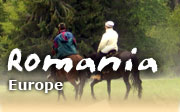
|
Horseback riding tours
Rides in
Romania
Intro to Romania
![]() Transylvania Transylvania
Bulgaria
Greece
Turkey
Cyprus
Europe Overview
Add Ons:
Hiking
Cycling
|

|
|

|
|
|

The landscape of Transylvania is reminiscent of pre-Industrial western Europe. This is due in part to the traditional non-intensive farming methods that continue to be practiced in this region. Approximately 500 people live in the village, the majority of which are involved in subsistence farming. Horses are found working the fields and the elegant scythe remains a key farming tool. This makes the countryside very wildlife-friendly; for example, bird species that are suffering a decline in western Europe continue to thrive in Transylvania. More visibly, the wealth of wild flower meadows that seem to coat the entire landscape in ever-changing colors in the spring and summer. Orchids also thrive here. Where flowers abound, so does insect life; in particular, butterflies. Armed with a field guide, a person can spend a whole day spotting rarities that are still considered common here!
Transylvania, as its name implies, is also a land of forests. Beautiful beech and hornbeam forests can be found near Miklósvár, changing to fir and spruce at the higher altitudes. During the spring, forests and ponds provide a home to yellow-bellied toads and fire salamanders. As autumn approaches, the forests change from vivid green to yellow and red, while a plethora of fungi and mushroom life coats the forest floor. Upland pastures, where the grazing of sheep takes place, resembles parkland with magnificent oaks and beeches intermingling with wild pear trees. Romanian shepherds and their formidable dogs can still be found here, safeguarding their flocks from predators.
The forests are also the preserve of the European brown bear and wolf, which have become predominantly nocturnal in their habits to avoid contact with humans. During the day, bears seek refuge in dense cover, such as young tree plantations, only venturing out to feed at dusk. The wolf is even more elusive. Wild boar, red deer and roe deer can often be spotted darting between trees. Tracks and signs of these animals can be found in the forests. Transylvanian winter is a particularly good time for snow tracking. During this period, thousands of bats can also be found roosting in caves.
Miklósvár
The village of Miklósvár is surrounded by rolling pastures, deciduous and coniferous forests, wild flower meadows, and deep valleys through which flows the River Olt and its tributaries. This Transylvanian region is also known as Erdővidék (which means ‘forest region’ in Hungarian). So rich in natural value, the area surrounding Miklósvár is currently a candidate for EU Natura 2000 designation. Some places near Miklósvár are already designated as nature reservations, including a wetland exhibiting important flora and fauna. Wildlife includes black stork, lesser spotted eagle, bee eaters, brown bear, wolf, and lynx to name but a few of the species present.
|

|
|
|
Transylvania Ride
Tour Code: IT-RORT01
7 days /
6 nights
~$1,990.00
Dates: April - October
Trip Rating :

Difficulty :

Lodging:  Introduction
Day to Day Itinerary
Rates
Introduction
Day to Day Itinerary
Rates |
Dates
Accomodation
Introducing Transylvania
Historic remains
Bram Stoker's Dracula
Tack:
English
Horses:
Shagya-Arabian, Lipizzaner, Gidran, an...
Pace:
Moderate with many opportunities for t...
Walk, Trot, Canter,
Airport:
Bucuresti Otopeni
Location on Google Map
Image Gallery
Image Slide Show
Customer Trip Rating
Climate
What To Bring
|
A |
Beginner
 |
Beginner A rider who has limited experience, is unable to post the trot and does
not canter.
|
|
B |
Novice
 |
Novice A rider who is capable of mounting and dismounting unassisted, capable of
applying basic aids, comfortable and in control at the walk, moderate length posting
trots, and short canters. |
|
C |
Intermediate

|
Intermediate A rider who has a firm seat, is confident and in control at all paces
(including posting trots, two point canters and gallops), but does not ride regularly. |
|
D |
Strong Intermediate
 |
Strong Intermediate An intermediate rider who is currently riding regularly and
is comfortable in the saddle for at least 6 hours per day.
|
|
E |
Advanced
 |
All of the above, plus an independent seat, soft hands, and capable of handling
a spirited horse in open country.
|
↑ Back to Top
|